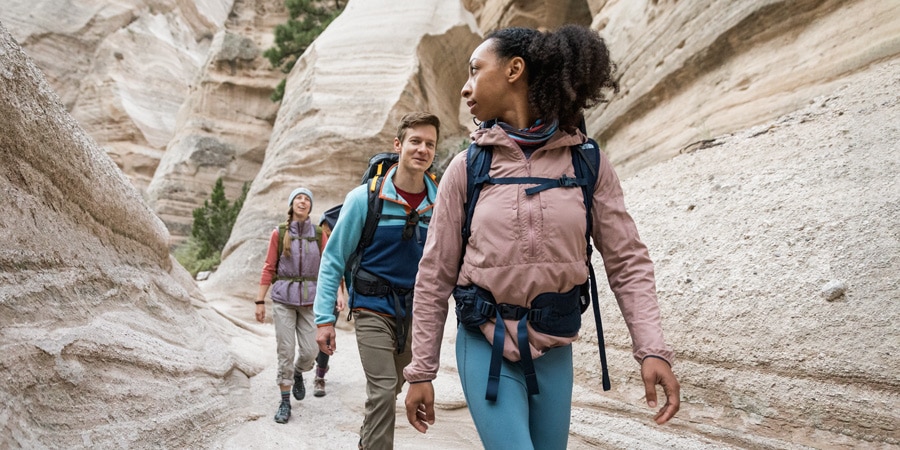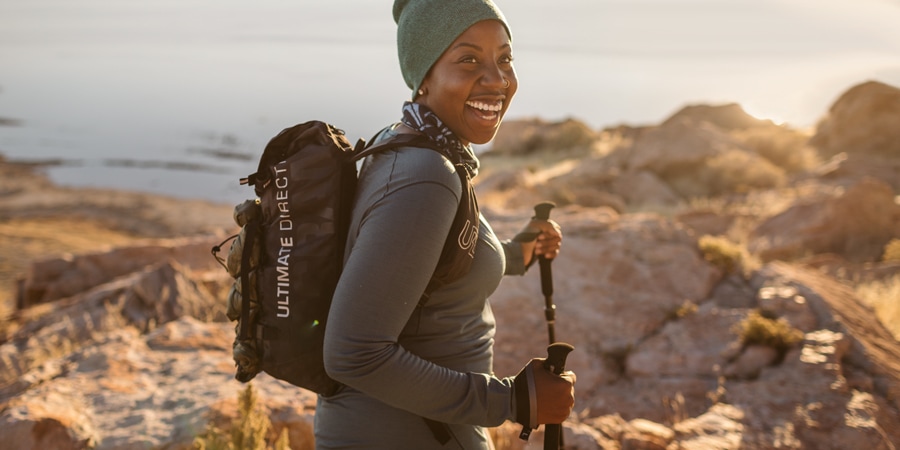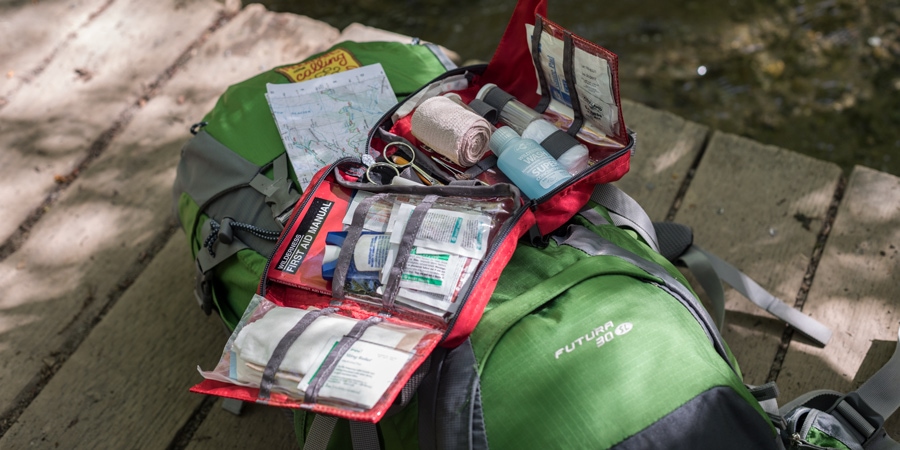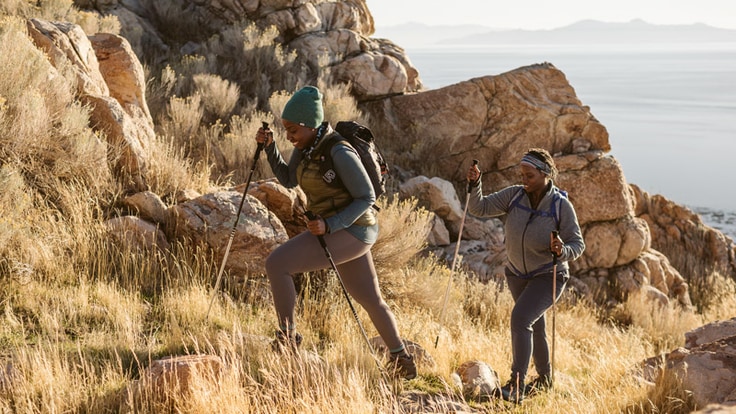Hiking is a wonderful way to immerse yourself in the outdoors. Transported by your own two feet and carrying only what you need for the day on your back, you can discover the beauty of nature at whatever pace you're comfortable with. And, with a little planning and preparation, it's an activity that almost anyone can do.
If you've dreamed of hiking, but have yet to try it, it's time to get out there. Just follow these steps:
Find a Hiking Partner

If you have friends who hike, ask them to take you on a trek. Most people are happy to share their expertise, let you borrow gear and introduce newbies to their favorite trails.
If you don't know any hikers, many cities and towns have hiking clubs that regularly plan outings. You can find hiking classes, outings and events through REI Experiences. Online groups are also a great way to find hiking buddies.
Hiking alone: Experiencing the outdoors by yourself can give you a sense of freedom and adventure that are hard to find elsewhere. But it can also be intimidating and lonely at times. If you're new to hiking, we recommend finding a companion to keep you company. That person will also be there to lend a hand if you happen to get hurt. If going alone really is your only option, then start out with short trips to popular hiking destinations and make sure someone always knows where you're going and how long you plan to be gone.
Choose a Hiking Route

There are several easy ways to find a hiking trail that will meet your needs:
- Guidebooks and websites are great resources because you can get all the stats you need: trail difficulty, distance, elevation gain, directions, water sources, trail features and whether dogs are allowed. Websites often display recent trip reports that may give you a sense for what current trail conditions are like.
- Word of mouth: If you have friends who like to hike, ask them to suggest some locations for you.
- Talk to locals: Contact a local hiking organization or call a ranger station in the area where you want to hike. Rangers typically have up-to-date trail conditions and are skilled at suggesting hikes for all skill levels.
Tips for Choosing a Hiking Route
Before you start your search for the perfect hike, it's helpful to think through a few things, such as:
- How much time you have: Do you have a couple hours or a full day? The amount of time you have can determine where you go. Don't forget to factor in how long it takes to get to and from the trailhead.
- Your fitness level: Honestly assess what kind of shape you're in. You want to have an enjoyable time out there rather than suffering through a long, strenuous hike that you're not prepared for. If you're not in the shape of your life, don't be dismayed: There are hikes for everyone. Read more fitness tips in our article on How to Train for Hiking.
- Distance: Think about how many miles and hours you're comfortable hiking. An average walking pace is about 3 mph, but your hiking pace may be slower than that depending on terrain, elevation gain and how much weight you're carrying on your back.
- Elevation gain: The amount of elevation gain on a hike is one factor that determines the difficulty. With a little experience, you'll come to know how much elevation gain you can comfortably handle and what is too much. For a point of reference, if a trail gains 1,000 feet in one mile, that is considered quite steep. Also, a general recommendation is that for every 1,000 feet of elevation gain, add one hour to your trip.
- Time of year and weather: Some trails won't be accessible in early spring because they're covered in snow. If it's fall and the sun is setting earlier, plan accordingly so you're not caught out after dark unexpectedly. Always check the weather forecast before heading out so you can dress and pack appropriately.
- Logistics: Certain hikes require a bit more planning. For instance, if you end up doing a hike that starts and finishes at different places, you'll need to shuttle cars to your start and end points.
Choose Your Hiking Gear

One of the wonderful things about hiking is that you don't need a bunch of high-tech gear to get out there. With a few essential items for the trail and a sense of adventure, you're ready to head into the wilderness.
The Ten Essentials
Start by making sure you're carrying the Ten Essentials. This is a collection of gear and clothing that all hikers should carry whenever they step onto the trail. The collection includes items for navigation, sun protection, insulation, illumination, first aid, fire, repairs, nutrition, hydration and emergency shelter. Learn more in our article about the Ten Essentials.
Hiking Footwear
Footwear is one of the most important items you need to choose, and it's a very personal choice. Some hikers prefer supportive over-the-ankle boots, while others enjoy lightweight trail-running shoes. The terrain you'll be walking on can also affect your decision. Lightweight, low-cut hiking shoes may be fine on well-maintained trails without a lot of obstacles, whereas sturdy boots may serve you better on a rugged trail with rocks, roots and streams. Read about some of our favorites in Best Hiking Boots.
Whatever you choose, make sure the boots or shoes are well broken-in and comfortable for long distances. And wear wool or synthetic socks, not cotton.
Learn more:
What to Wear Hiking
Choose clothing made of quick-drying, moisture-wicking fabrics, such as wool or polyester. Avoid cotton, which takes a long time to dry when wet. You can think of clothing as separate systems:
- Next-to-skin base layers: Made of wool or polyester, base layers are most important in cool to cold temperatures.
- Hiking layers: These include nylon and/or polyester pants, T-shirt, sun shirt, sun hat.
- Insulation: Depending on the weather, you may need a puffy vest or jacket, lightweight fleece pullover, warm hat and gloves.
- Rainwear: It's wise to carry a waterproof jacket no matter the weather forecast. If you're expecting wet weather, bring the rain pants along, too.
Hiking Backpack
Of course, you need a pack to carry your Ten Essentials and any extra gear.
For short treks on trails that are close to home and on days with pleasant weather, a daypack with a capacity of about 15-20 liters provides enough space for water, a few snacks and a lightweight clothing layer.
When you venture farther into the wilderness, you'll need to carry more gear, clothing, water and food. A pack with a capacity of about 30 liters is a good choice for these journeys.
Learn more in our How to Choose Daypacks article.
Food and Water
As a beginner hiker, it can be tough to know how much food and water you need, A good general recommendation for how much to eat is 200-300 calories per hour. For water intake, about a half liter per hour of moderate activity in moderate temperatures is a good starting place. These amounts depend heavily on several factors, such as the intensity of your hike, the weather, your age, your sweat rate and your body type. As you gain more experience, you'll get a better sense for just how much you need.
It's always a good idea to carry a little extra food and water in case your trip takes longer than anticipated.
Learn more:
Water treatment: Many hikers carry all the water they will need for a day hike. However, if you anticipate needing more than about 3 liters, that can be quite heavy. By filtering and treating water from backcountry streams and lakes, you refill your water bottles or hydration reservoir and reduce your load.
Learn more:
Additional Hiking Considerations

Personal Health and Safety
First aid: You don't need to be a medical pro to take a hike, but it's wise to know some basic first aid. Always carry a first-aid kit and know how to use it. The farther afield you go, the more important it can be to have medical training.
REI Experiences: Wilderness First-Aid
Take a class to be better prepared to respond to medical emergencies in the outdoors.
Going to the bathroom: Going to the bathroom in the woods is a concern of many novice hikers. But rest assured, it's something countless people have learned to do, and so can you.
If you just have to pee, simply find a place that's well away from the trail and at least 200 feet (about 70 steps) from water sources. For women, you can "shake dry" or you can bring a couple wads of toilet paper and a small zip-top plastic bag. Put the used toilet paper in the bag and dump the paper in your toilet when you get home. Another option is to use a bandana as a "pee rag" that you can tie to the outside of your pack to dry out.
Most day hikers take care of their other business before they head out. But if the urge strikes midhike, again make sure you're off the trail and 200 feet from water. Then, dig a hole about 4 inches wide and 6-8 inches deep to bury your poop (a camp trowel can help with the digging). Experienced hikers might wipe with natural objects, such as large leaves (make sure they're not poisonous), smooth stones and even snowballs, but you can also use toilet paper and bury it in the hole. In some areas, you'll be required to pack out your used toilet paper (and even if it's not required, it's still best practice for lowering your impact on the land). Some high-elevation, sensitive or heavily traveled areas require people to pack out solid human waste. If you're going to one of these areas, bring human waste disposal bags.
After you're done going to the bathroom, use some hand sanitizer to "wash" your hands.
Learn more tips in our Backcountry Bathroom Basics article.
Hiking with your period: If you're hiking with your period, you'll want to bring along menstrual supplies and know how to manage them efficiently. And if you're hiking alone, there are some good tips that other backpacking women have shared to help you feel confident and prepared.
Learn more:
Safety: Always leave a detailed itinerary with a friend or family member. Leaving a note with your route plans inside your vehicle is a good way to inform search-and-rescue folks of your plan if they come looking for you (just don't leave the note in plain view for trailhead thieves to see).
If you're traveling solo or to very remote locations, you might consider carrying a personal locator beacon (PLB) that allows you to send an SOS if something serious happens.
Learn more in our article PLBs and Satellite Messengers: How to Choose.
Trail Etiquette
Whether you've been hiking for years or you're gearing up for your first trek, it's valuable to know some basic trail etiquette.
Right of Way: Following these rules of the trail can help everyone get along:
- Hikers vs. Hikers: Hikers going uphill have the right of way. You may see uphill hikers let others come downhill while they take a breather, but remember that's the uphill hiker's decision.
- Hikers vs. Bikers: Mountain bikers are generally expected to yield to hikers. However, because mountain bikers are usually moving faster than hikers, it can be easier for hikers to step aside and yield the right of way.
- Hikers vs. Horses: Horses get the right of way. If you're sharing the trail with equestrians, give them a wide berth when you're passing each other and don't make abrupt movements. It's generally recommended to step off the trail to the downhill side while yielding to a horse.
Leave No Trace: While most of us don't intend to harm our natural surroundings, we may not know how to preserve them, or we're simply overlooking a few important behaviors. Leave No Trace provides seven principles that provide guidance for enjoying the outdoors in a sustainable way that avoids human impacts. The seven principles are:
- Plan ahead and prepare
- Travel and camp on durable surfaces
- Dispose of waste properly
- Leave what you find
- Minimize campfire impacts
- Respect wildlife
- Be considerate of other visitors
Learn more in our Leave No Trace Principles article.
Hiking with Kids and Dogs
Kids: Sharing the wonder and beauty of the outdoors with children is a special experience. Kids of almost any age can go hiking, from infants in baby carriers to grade-schoolers who hike on their own two feet.
Tips:
- Keep kids dry, warm and fed
- Choose a short hike and stop often to look at plants, rocks, animals, etc.
Learn more about Hiking with Infants, Toddlers and Kids and get Tips on How to Make Hiking With Kids Fun.
Dogs: If you have a four-legged friend that you're comfortable hiking with, the first step is to find out if dogs are allowed where you're going. Most U.S. national parks, for example, do not allow even a leashed dog to share the trail. Many national forests, as well as state and local parks, do allow dogs, though rules vary. Leashes are mandatory almost everywhere.
Tips:
- Have your dog carry its own food and water in a dog pack
- Stop often for snacks and water
- Always pack out filled poop bags. Also, while you're hiking, it's poor form to leave a poop bag on the side of the trail for later pickup.
Learn more about Hiking or Backpacking with Your Dog or shop hiking gear for your dog.




